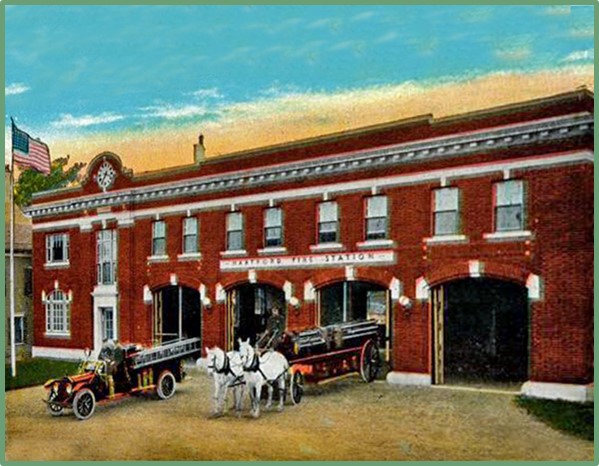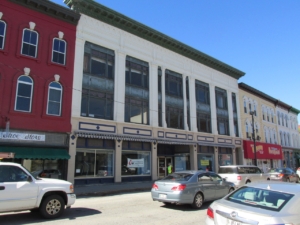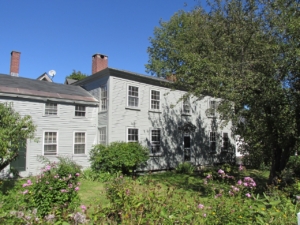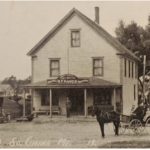Up and down the Kennebec Valley: Historic listings, Augusta part 8
by Mary Grow
Just south of the historic buildings at the north end of the west side of Augusta’s Water Street (described in last week’s article) is a much newer building that gained a place on the National Register of Historic Places on May 2, 1986. The D.V. Adams Co .- Bussell and Weston Building, at 190 Water Street, was built in 1909. Wikipedia calls it “one of the state’s best early examples of a department store building.”
Like its northern neighbors, it is built of brick and three stories tall, but the front has much more window space, particularly on the upper floors. The street level has five separate bays, the center one a recessed entrance.
Wikipedia says Boston architects Freeman, Funk and Wilcox designed the building for Bussell and Weston. Roger Reed, writing for the Maine Historic Preservation Commission, calls the architectural firm Freeman, Frank and Wilcox – Web references do not resolve the discrepancy – and says Bussell and Weston was a dry goods company.
The original building had what Wikipedia calls a stepped parapet. On-line photos show stepped parapets having more than one level, as the name suggests. Reed wrote that the present Italianate cornice, similar to but elevated slightly above its neighbors, replaced the original sometime between 1912 and 1920.
One on-line source calls the architectural style Classical Revival, and others mention the Chicago style windows on the upper floors. Reed says Bussell and Weston intended, and their architects achieved, a building that would stand out from its neighbors.
In 1920, department store founder and owner Delbert W. Adams bought the Bussell and Weston building and contents and moved from his 1910 store on the east side of Water Street. His store closed in 1982, according to Augusta’s on-line Museum in the Streets; Reed’s report says a department store used the building until 1985. The name change from D. W. Adams to D. V. Adams is nowhere explained.
In 1985, Reed listed the building owner as G. T. G. Association. His description commented on the unchanged interior space, “complete with iron columns, wooden staircase and pressed metal ceiling.”
While on Water Street, it seems appropriate to describe the Hartford Fire Station, although at 369 Water Street it is south of the boundary of the Water Street historic district that this series has covered beginning with the Feb. 4 The Town Line piece.
The station’s alternate address is 1 Hartford Square. It is southeast of the south end of Water Street, with Gage Street on the northeast and the backs of the buildings lining Swan Street on the southwest. Built in 1920, the Hartford Fire Station was added to the National Register of Historic Places in 2017, as a $6 million addition and renovation project was under way.
The large two-story brick building was designed by local architects Bunker and Savage, established in 1916 and still in business. An on-line Maine Preservation article calls its style Classical Revival.
The same article says the name recognizes George Huntington Hartford, whose son donated the land for the building.
George Huntington Hartford (Sept. 5, 1833 – Aug. 29, 1917) was born on an Augusta farm. By the time he was 18, he was in Boston starting a career in retail businesses. In 1861 he was in Brooklyn, New York, where he was hired as a clerk in George Gilman’s Great Atlantic and Pacific Tea Company.
Wikipedia says Hartford moved up in the firm until he became a partner when Gilman retired in 1878 and effectively ran the company until Gilman died in 1901. After Gilman’s death, Hartford bought out his heirs and ran what was by then A & P until his own death, though two of his sons took over day-to-day management in 1907 or 1908. Hartford invented the idea of a chain of grocery stores, and before he died he and his sons made A & P the largest retailer in the United States.
The 1920 Hartford fire station was the first in Augusta to have a fire horn that could signal fire locations to everyone in the city, and the first to be designed to accommodate motorized as well as horse-drawn fire equipment.
As fire trucks became larger and heavier, the station ran out of space and the floors began to deteriorate. In 2016, work started on an addition, plus repairs and interior remodeling of the original building. The on-line Maine Preservation article lists many people responsible for the successful project, including Fire Chief Roger Audette and Sutherland Conservation and Consulting (SCC), of Augusta.
SCC was founded in 2007 by Amy Cole Ives, of Hallowell, who previously spent eight years working for the Maine Historic Preservation Commission. In May 2008, the SCC website says, Maine Historic Preservation gave her a Statewide Historic Preservation Honor Award for her role in promoting legislation that led to the state’s Tax Credit for the Rehabilitation of Historic Properties and the Maine Uniform Building and Energy Code (MUBEC).
Ives’ specialty is analysis of historic paint and other finishes on buildings, vehicles and art works. In March 1917 she helped organize the sixth International Architectural Paint Research (APR) Conference at Columbia University in New York City. She also presented a paper there.
(The third APR conference was in January 2008, also at Columbia University. The fourth was in 2010, in Lincoln, in the United Kingdom. The fifth was in March 2014 in Stockholm, Sweden. The seventh was scheduled for Tel Aviv University, Israel, in October 2020, and was retitled, more broadly, the Architectural Finishes Research Conference. It was rescheduled to a January 2021 virtual conference.)
In October 2020, Ives announced that SCC was absorbed by MacRostie Historic Advisors (MHA), LLC, with at least one employee joining MacRostie’s Boston office. Ives planned to continue consulting on historic paint.
The statement that Augusta has four designated historic districts that opened the Feb. 4 article was an error by this writer. The city has five designated districts: the Water Street commercial district that has been described; the Capital District around the State House on State Street, to be described in the next article; and three residential districts, Bond Street, Crosby Street and Winthrop Street.
The residential historic districts contain mostly private houses that are not open to the public. Should readers care to visit them, owners’ rights and privacy are to be respected.
Bond Street is a short street that connects State and Water streets, just south of Bond Brook. The historic district includes seven one-and-a-half story wooden residential buildings, numbers 8, 9, 12, 18, 21, 22 and 25. All were built between 1878 and 1884 by Edwards Manufacturing Company to house employees in its textile mill. The company sold them to private owners in 1946.
Wikipedia says there are two four-unit buildings and a single-family house on the north side of Bond Street and four duplexes on the south side. All are similar in style. In 1900, the census found 167 people in 20 families living in the buildings.
Although other Augusta mill owners provided employee housing, Wikipedia says the Bond Street buildings are the only ones still standing in the city. The historic district was listed on April 11, 2014.
Crosby Street is a dead-end street south of and uphill from Bond Street. It runs north off Bridge Street, parallel to State Street above it and roughly parallel to Water Street below it. Crosby Lane connects the middle of Bond Street to State Street.
The Crosby Street historic district, listed Sept. 11, 1986, encompasses eight houses: one on State Street, one on Crosby Lane and six on the south end of Crosby Street. These are elegant, stylish homes, the earlier ones Federal and the later Greek Revival style, and would have been built for business and professional men.
The large two-story Federal George Crosby House at 22 Crosby Lane, with a story-and-a-half ell almost as big, is the oldest of the seven, Wikipedia says. Built around 1802 for businessman George Crosby, it was followed about 1806 by a similar house next door built for John Hartwell, described as a carpenter and auctioneer.
A Maine Historic Preservation Commission piece quoted online says the two houses have doorways designed from the1797 “Country Builder’s Assistant”, by Asher Benjamin, one of many architectural plan books that helped builders in places like Maine follow national style trends.
The Crosby house was the home of Governor Samuel Smith from 1832 to 1834. His choice led to additional generously-sized houses built by Eben Fuller and William Hunt, among others.
George Crosby is listed in Captain Charles E. Nash’s chapters on Augusta in Kingbury’s Kennebec County history as the first cashier of the Augusta Bank, chartered Jan. 21, 1814.
John H. Hartwell was born in Lincoln, Massachusetts, Jan. 2, 1787. He married Eliza Brooks (1789-1864) on May 31, 1810, in Hallowell, and they had two sons and six daughters. He died March 6, 1859, in Augusta.
Nash wrote that Eben Fuller (Jan. 25, 1795 – Oct. 7, 1873) opened the Fuller drug store in 1819. The building burned in the September 1865 fire, and Eben and his only son, Henry Lucius Fuller (1827-1875), rebuilt it. Eben Fuller married Eliza Williams (1799-1883); they had one son and four daughters.
The Winthrop Street historic district is the largest of the three residential districts, covering about 100 acres. When the district was designated on Aug. 6, 2001, it included 192 buildings on Chapel, Chestnut, Court, Green, State and Winthrop streets. On Dec. 30, 2008, Wikipedia says, the district boundary was expanded to add the 1830s Federal house at 20 Spring Street.
Winthrop Street runs approximately west from Water Street to the Augusta airport. It separates Mount Hope Cemetery on the north from Forest Grove Cemetery on the south.
Some of the earliest houses in the historic district date from 1815 or before. Most were built between 1830 and 1850, after the state capital was moved to Augusta by law in 1827 and, in fact, in 1832. New houses continued to be built for residents involved in Augusta’s publishing (see The Town Line, Nov. 12, 2020) and manufacturing enterprises until around 1915.
Non-residential buildings include Lithgow Library, the Kennebec County Courthouse, at 95 State Street (see Jan. 7; the Lot Morrill house on Winthrop Street described there is also inside the historic district) and two churches. A variety of architectural styles are represented, with Federal, Victorian and Colonial Revival dominant, Wikipedia says. Some of the former residences now house professional offices.
NOTE ON SHURTLEFF HOUSE
Readers who planned to look at the Shurtleff House, on Route 201, in Winslow, (see The Town Line, Jan. 28, 2021) will not find it. Michael Fortin, owner of Fortin’s Home Furnishings, on the east side of Route 201, said when the property went up for sale, he bought it because he owned adjacent land. When he inspected the neglected house, he found it was “far beyond repair” and, with regret, had it demolished on Feb. 19, 2021.
Main sources
Kingsbury, Henry D., ed., Illustrated History of Kennebec County Maine 1625-1892 (1892).
Websites, various
Next: Augusta’s Capitol Complex Historic District.
Responsible journalism is hard work!
It is also expensive!
If you enjoy reading The Town Line and the good news we bring you each week, would you consider a donation to help us continue the work we’re doing?
The Town Line is a 501(c)(3) nonprofit private foundation, and all donations are tax deductible under the Internal Revenue Service code.
To help, please visit our online donation page or mail a check payable to The Town Line, PO Box 89, South China, ME 04358. Your contribution is appreciated!








Born and brought up on Sewall Street. Blaisdell street named after my grandfather, Stephen Blaisdell. I have lots of history of Augusta.